SBI Large and Midcap Fund: 33 times returns in 27 years

If you had invested Rs 1 lakh in SBI Large and Midcap Fund (erstwhile SBI Magnum Multiplier Fund) at the time of its inception in early 1993, your investment would have grown to Rs 33 lakhs (as on 22nd November 2019). Rs 10,000 monthly SIP in the scheme over the last 10 years would have grown to a corpus of nearly Rs 24 lakhs (as on 22nd November 2019), with a cumulative investment of Rs 12 lakhs. The credentials of SBI Large and Midcap fund as a wealth creator are quite strong.
Large and Midcap Mutual Funds
According to SEBI’s directive large and midcap schemes must mandatorily invest at least 35% of its assets in large cap stocks and at least 35% of its assets in midcap stocks. SEBI classifies the top 100 stocks by market capitalization as large cap stocks and the next 100 stocks by market capitalization as midcap stocks. SEBI’s mandate for large and midcap schemes is quite flexible allowing considerable freedom to fund managers in terms of market cap mix according to their outlook.
SBI Large and Midcap Fund - Overview
SBI Large and Midcap Fund (erstwhile SBI Magnum Multiplier Fund) was launched in February 1993. The scheme name was changed in 2018. The scheme has Rs 2,753.29 Crores of Assets underManagement (AUM) as on 31st October 2019 with an expense ratio of 2.15%. Saurabh Pant is the fund manager of this scheme. The scheme benchmark is Nifty Large and Midcap 250 TRI. The scheme has given 14.05% CAGR (annualized) returns since inception. The chart below shows the NAV movement of the scheme versus the benchmark over the last 5 years.
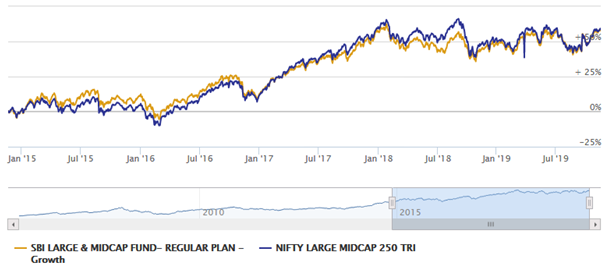
Source: Advisorkhoj Research
Strong relative performance
The chart below shows the trailing returns of SBI Large and Midcap Fund across different time-scales (periods ending 22nd November 2019) versus its benchmark, category and other asset classes (e.g. gold, fixed income etc). You can see that the scheme outperformed the large and midcap funds category and other asset classes over longer tenures. Over the last 1 year, the scheme underperformed versus the average category returns, but again turned the corner 3 months back and is again outperforming the category.
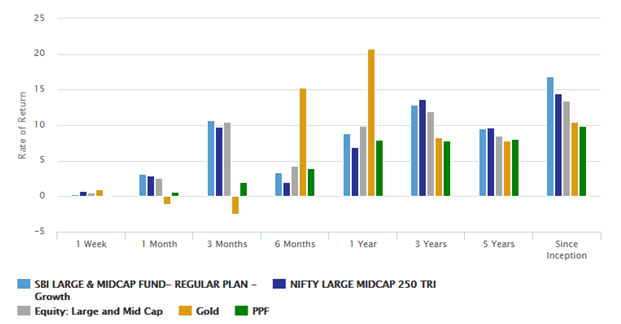
Source: Advisorkhoj Research
Rolling Returns
We have stated a number of times in our blog that rolling returns are the best measures of mutual fund performance because they are not biased by market conditions prevailing during a particular period. The chart below shows the 3 year rolling returns of SBI Large and Midcap Fund versus the scheme category over the last 5 years. You can see that the scheme consistently outperformed the large and midcap funds category over 3 year rolling returns period (investment tenures) across different market conditions over the last 5 years. Performance consistency is one of the most important attributes of good fund managers which enable them to create wealth for investors in the long term.
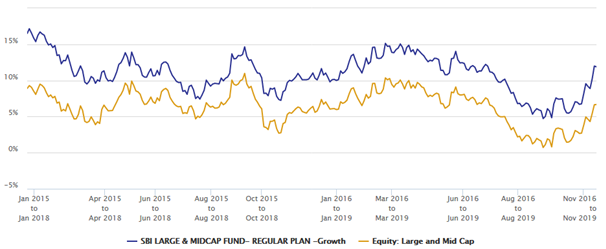
Source: Advisorkhoj Research
The average and median 3 year rolling returns of SBI Large and Midcap Fund over the last 5 years were 11% each. The maximum 3 year rolling return of the scheme was 17% and the minimum 3 year return was 5%. The scheme gave 8%+ annualized 3 year rolling returns 85% of the times over the last 5 years.
Portfolio Construction
The market cap mix of the scheme is currently almost evenly balanced between large cap (41%) and midcap (44%). The remaining portion of the portfolio primarily comprises of small cap stocks. From a sector composition standpoint, banking and financial services, construction, engineering, services, FMCG, automobiles, energy and technology are the major sectors. The scheme is well diversified in terms of company concentration.

Source: Advisorkhoj Research (as on 31st October 2019)
Lump Sum and SIP Returns
The chart below shows the growth of Rs 1 lakh lump sum investment in the scheme over the last 5 years. You can see that, money invested in the SBI Large and Midcap Fund would have grown almost 60% over the last 5 years (as on 22nd November 2019).
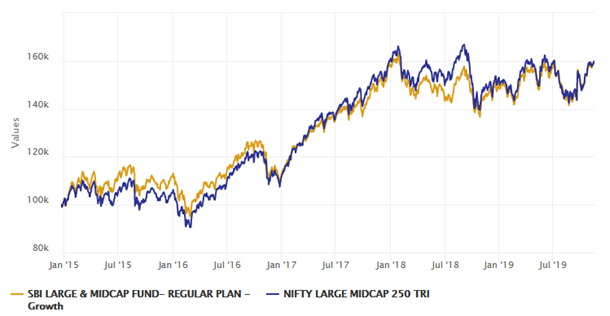
Source: Advisorkhoj Research
The chart below shows the growth of Rs 5,000 monthly SIP in the scheme over the last 10 years. Your investment would have grown to Rs 11.82 lakhs in value – profit of nearly Rs 565,000 (as on 22nd November 2019). The annualized SIP return in the last 10 years was around 12.79%.
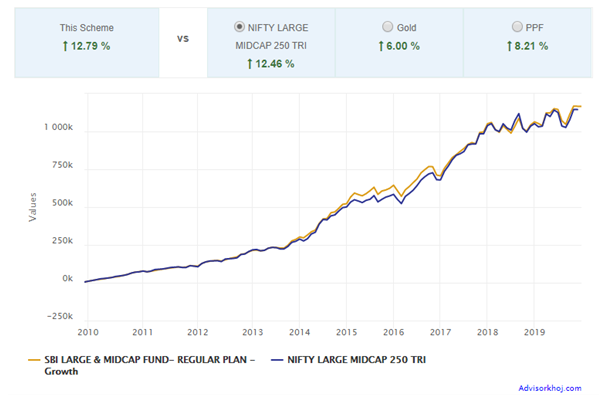
Source: Advisorkhoj Research
Summary
In this post, we reviewed SBI Large and Midcap Fund. The scheme has a proven track record of wealth creation. Investors should have long investment horizons for this scheme for financial goals like retirement planning, children’s higher education, children’s marriage, wealth creation etc. You can invest in this scheme either in lump sum or SIP depending on your investment needs. If you have lump sum funds but are worried about volatility in the short term then you can invest your funds in SBI Liquid Fund and then transfer it to SBI Large and Midcap Fund through Systematic Transfer Plan (STP) over the 3 – 6 months. Investors should consult with their financial advisors if SBI Large and Midcap Fund is suitable for their investment needs.
Mutual Fund Investments are subject to market risk, read all scheme related documents carefully.
RECOMMENDED READS
- Demystifying debt mutual funds
- Why Balanced Funds may be the best investments for new mutual fund investors
- How do you know if you have good funds in your mutual funds portfolio: part 1
- Know your mutual fund tax obligations to manage your investments effectively
- Asset Allocation is much more important than fund selection
LATEST ARTICLES
- SBI Dynamic Asset Allocation Active FOF: A smart asset allocation solution in shifting markets
- Your perfect Gift for your little ones this Childrens Day: SBI Magnum Childrens Benefit Fund Investment Plan One of the best performing funds for your childs future
- Magnum Hybrid Long Short Fund: A smart investment option in challenging conditions
- Delivering Returns with Resilience: SBI Multicap Funds proven multicap strategy
- SBI Equity Hybrid Fund: One of the top performing hybrid funds in current market conditions
Quick Links
Follow SBI MF
More About SBI MF
POST A QUERY





